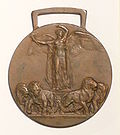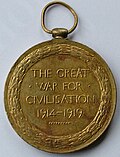Top Qs
Timeline
Chat
Perspective
Inter-Allied Victory Medal (Greece)
Greek World War I medal From Wikipedia, the free encyclopedia
Remove ads
The Inter-Allied Victory Medal (Greek: Διασυμμαχικόν Μετάλλιον της Νίκης) is a campaign medal issued by Greece, commemorating the Allied victory in the First World War.[1]
Obverse (left) and reverse (right) views of the medal
Greek award
The medal is the Greek version of a common design used among all Allied nations, following a proposal made by Marshal Ferdinand Foch, who was supreme commander of the Allied Forces during the war.[1] In Greece, the medal was instituted by Law 2481 on 22 September 1920 (O.S.).[1]
Each medal, in bronze, has the same diameter (36 mm) and ribbon (double rainbow), but with a national design representing a winged Victory. The Greek version of the medal was designed by Henry-Eugène Nocq.
It features an ancient Greek-style Victory on the obverse, and on the reverse the circular inscription Ο ΜΕΓΑΣ ΥΠΕΡ ΤΟΥ ΠΟΛΙΤΙΣΜΟΥ ΠΟΛΕΜΟΣ 1914—1918 ('The Great War for Civilisation, 1914–1918') around the edge, and in the centre a list of the Allied nations, under the title ΣΥΜΜΑΧΟΙ ΚΑΙ ΕΤΑΙΡΟΙ ('Allies and Partners').[1] It was widely awarded to Greek military personnel that fought for at least three months, or was wounded in action, not only in the First World War, but also in the Allies' Southern Russia intervention, and the Greco-Turkish War of 1919–1922.[1]
Remove ads
International award
Summarize
Perspective
Remove ads
References
Sources
External links
Wikiwand - on
Seamless Wikipedia browsing. On steroids.
Remove ads































